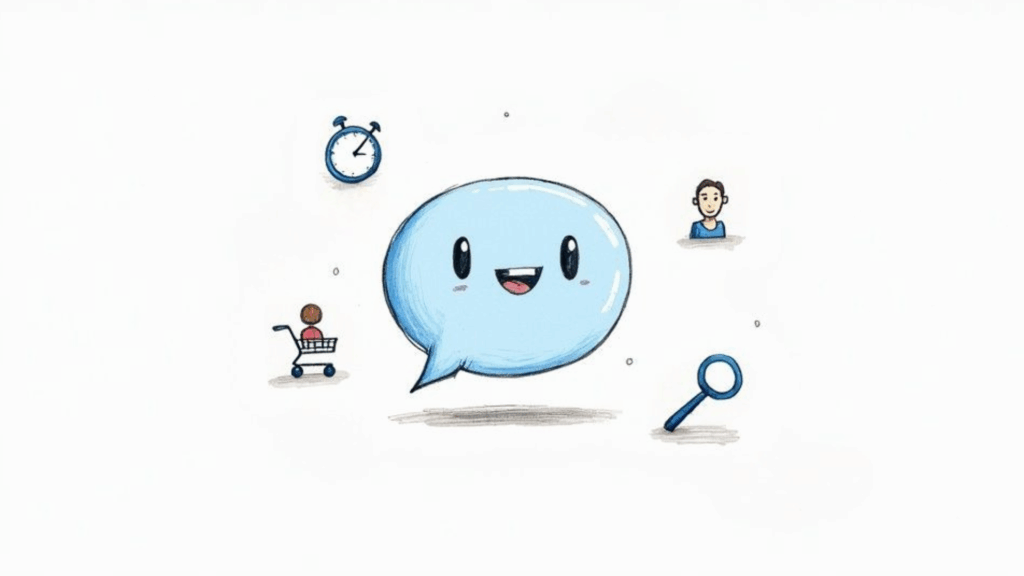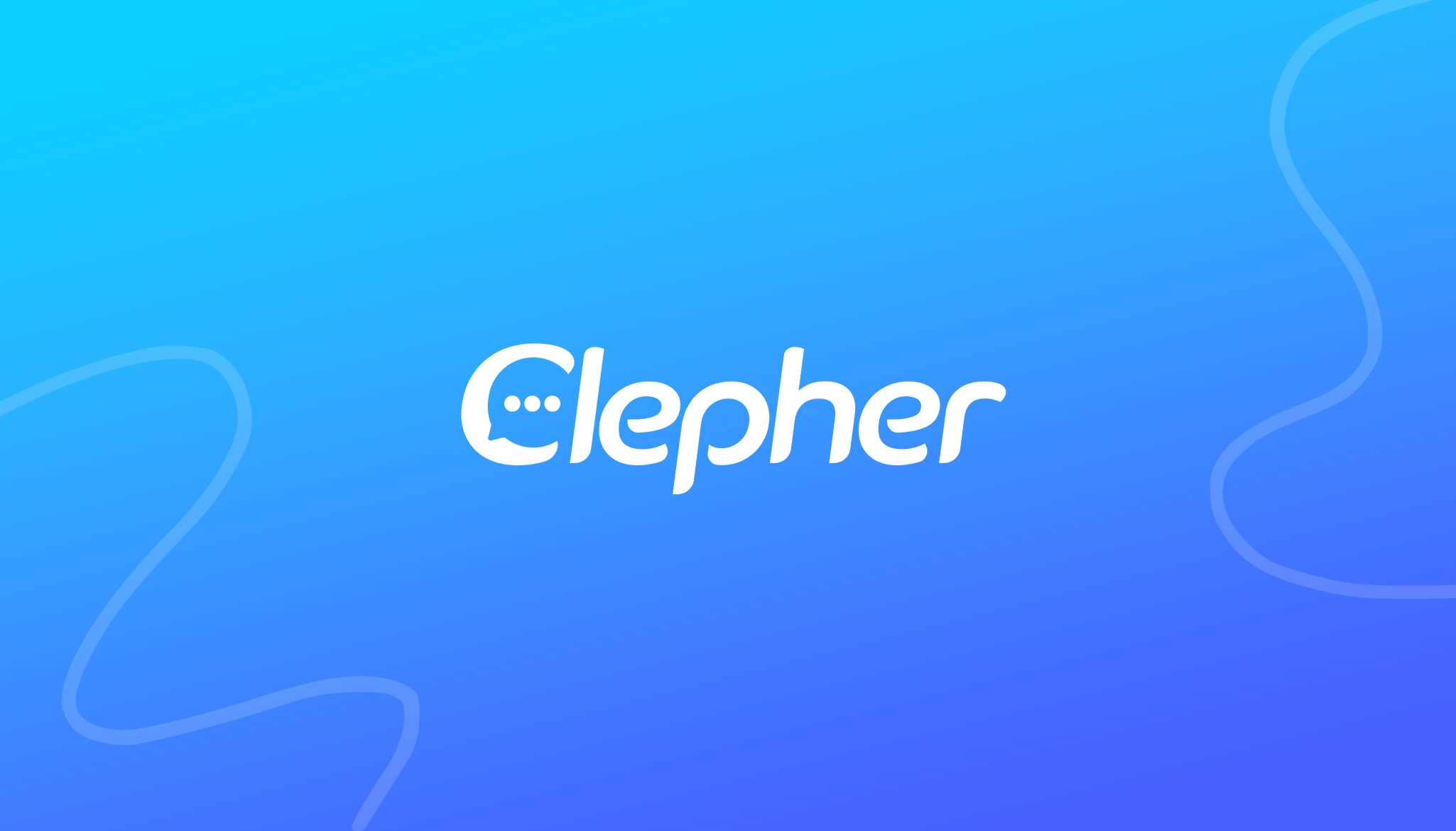Imagine you had a team member who worked 24/7. They never sleep, never take a break, and are always ready to answer customer questions, qualify leads, and even guide people straight to a purchase—all inside Facebook Messenger.
That’s the simplest way to think about chatbots on Facebook. They’re smart, automated conversation partners for your business, turning your Page into an interactive machine that drives real results.
What Are Facebook Chatbots Really Used For

facebook chatbots
Think of a chatbot as an intelligent assistant that lives right inside your Facebook Business Page. When a visitor lands on your page, they can hit the “Message” button and instantly get value, instead of just scrolling through posts.
This isn’t about replacing your human team. It’s about making them more powerful. Chatbots handle repetitive, predictable questions, freeing up your staff to solve the complex problems that truly need a human touch.
Transforming Static Pages Into Interactive Hubs
Your average Facebook Page is a one-way street. You post content, people might react, and the conversation ends there. Once you introduce a Messenger bot, that same page shifts into a two-way conversation hub that stays awake even when you’re not. It becomes a chatbot for Facebook that greets every visitor with instant, intelligent responses.
This shift is powerful. In a world where attention evaporates in seconds, customers get answers the moment they need them. A well-built Messenger bot can immediately:
- Answer FAQs: Give instant details about hours, locations, shipping, or services.
- Guide users to products: Ask a few quick questions and recommend the perfect choice.
- Capture lead information: Collect emails, phone numbers, and preferences on autopilot.
- Schedule appointments: Book calls, demos, or reservations directly inside Messenger.
Behind the scenes, a Facebook chatbot runs on automated conversational flows. You map out the paths your visitors normally take, and the bot handles them with fast, personalized replies at scale.
Understanding the concept of content automation helps clarify how this powerful engine works behind the scenes.
The Scale of Facebook Messenger Automation
The opportunity here is massive. There are already over 300,000 active chatbots on Facebook Messenger, serving millions of people every day.
With more than 40 million businesses using Messenger to talk to customers, automation has gone from a nice-to-have to a must-have for standing out. These bots aren’t a gimmick; they’re a core piece of modern marketing and customer service.
Ultimately, a chatbot acts as the digital front door for your business on the world’s biggest social network. It greets every visitor, figures out what they need, and points them toward a solution—turning passive browsers into active, engaged leads.
For a deeper dive, check out our complete guide on what a Facebook Messenger chatbot is.
Why a Chatbot Is a Strategic Business Move
Bringing a chatbot onto your Facebook page isn’t just a tech upgrade. It’s a strategic investment that fundamentally changes how you connect with customers, capture leads, and streamline your operations.
For many businesses, a chatbot quickly becomes their most efficient employee. It’s the team member who never sleeps, ensuring you don’t miss a single opportunity just because it’s after 5 PM or a weekend.
Here’s your section rewritten with your terms woven in naturally and the same clean, structured format:
Radically Improve Customer Response Times
In today’s impatient market, speed decides who earns the sale. A chatbot for Facebook Messenger eliminates the wait entirely. With automated replies powered by smart chatbot integration and natural language processing, your audience gets the information they want the moment they ask. This instant clarity builds trust, strengthens loyalty, and elevates your brand’s reputation for responsiveness.
Unlock True 24/7 Availability and Lead Capture
Your business might close for the day, but your audience is still scrolling, shopping, and asking questions. With a chatbot for Facebook Messenger running nonstop, you gain a round-the-clock agent that qualifies leads, books appointments, and answers key questions at any hour. This continuous support transforms your Facebook Messenger marketing into a full-time lead-generation engine, collecting names, contact details, and intent signals while your team sleeps. Every morning becomes a fresh batch of warm prospects already nurtured by automation.
Increase Operational Efficiency and Reduce Costs
Most teams are buried under repetitive questions that drain time and energy. A Messenger chatbot takes over those routine interactions so your people can focus on more nuanced, high-value work. By automating these first-layer conversations through chatbot integration, you handle a far larger volume of inquiries without expanding your staff. The result is smoother operations, lower costs, and a support experience that feels polished and effortless.
This cuts operational costs and lets your team focus on more fulfilling work. Understanding the bigger picture of automation for business makes it clear why chatbots are such a game-changer.
Deliver Hyper-Personalized Marketing at Scale
Generic, one-size-fits-all marketing no longer cuts it. Facebook Messenger chatbots are the perfect tool for delivering personalized experiences to a huge audience.
Based on how a user interacts, a chatbot can automatically sort them into different audience segments. This lets you send targeted follow-up messages, promotions, and content that speaks directly to their interests.
For example, an e-commerce chatbot can segment users based on:
- Product Interests: If someone asks about running shoes, the bot tags them for future promotions on athletic footwear.
- Purchase History: The bot can identify past customers and offer them exclusive loyalty discounts.
- Engagement Level: Users who complete a quiz can be flagged for a special follow-up campaign.
This one-on-one personalization leads to higher open rates, click-through rates, and more sales. You’re no longer just shouting a message; you’re having a tailored conversation with each person. To dig deeper, check out the many benefits of AI chatbots in our other guide.
How Businesses Win with Facebook Chatbots
Theory is great, but let’s focus on what matters: how chatbots in Facebook drive real-world results. These aren’t just tech toys; they are workhorses delivering measurable growth for businesses of all kinds.
Let’s look at how companies are solving everyday problems and seeing serious growth by automating their Facebook Messenger conversations. Each example is a simple story: a problem, a chatbot solution, and a win.
E-commerce Personal Shopping Assistants
For any online store, a key challenge is replicating the helpful, one-on-one experience of a physical shop. A chatbot is the perfect solution—a digital sales associate that’s on duty 24/7, ready to help customers find exactly what they need.
Imagine someone messages your Page at 11 PM looking for running shoes. Instead of making them wait, a chatbot jumps in immediately. It asks smart questions like, “Are you looking for trail or road running shoes?” or “What’s your typical weekly mileage?”
Based on their answers, the bot instantly presents a curated selection of products, complete with photos and a “Buy Now” button. This guides a customer from casual interest right to checkout.
This transforms the shopping experience by:
- Providing instant product recommendations: No more endless scrolling for the customer.
- Handling post-purchase support: The bot can answer “Where is my order?” or even initiate a return.
- Recovering abandoned carts: The bot can send a friendly reminder an hour later, perhaps with a small discount to seal the deal.
Qualifying High-Value Leads in Real Estate
In fields like real estate, lead quality is everything. Agents can burn hours sifting through messages to find serious buyers. A Facebook chatbot automates this entire screening process.
When a potential buyer messages an agent’s page, the chatbot can start a qualification chat.
It asks the make-or-break questions right away: “What is your desired budget?” “How many bedrooms are you looking for?” and “Are you pre-approved for a mortgage?” This simple, automated exchange instantly separates hot leads from window shoppers.
By the time a human agent steps in, they already have a full profile on a motivated, qualified buyer. This frees them to focus on showing homes and closing deals, making sure every lead handed over is worth pursuing.
Streamlining Bookings for Local Businesses
For local service businesses—restaurants, salons, dental offices—managing appointments is a constant administrative task. A Facebook chatbot turns this manual process into a smooth, automated flow that customers love.
Imagine someone wants to book a table for dinner. They can message the restaurant’s Facebook Page, and the bot will ask for the date, time, and number of guests. It then checks real-time availability and confirms the booking on the spot.
But it gets even better. A well-built bot can also:
- Send Automated Reminders: Send a message 24 hours before the appointment to reduce no-shows.
- Upsell and Promote: Before a hair appointment, a salon’s bot might ask, “Would you like to add a deep conditioning treatment?”
- Gather Feedback: After the visit, the bot can follow up to ask for a review, helping the business build social proof.
Each of these examples shows how businesses use Messenger chatbots to solve specific problems, create better customer experiences, and ultimately, drive revenue. To see more use cases, check out how businesses leverage Messenger chatbots for success in our detailed guide.
Choosing the Right Chatbot Builder for Your Needs
A chatbot’s success depends heavily on the platform you build it on. When you start exploring chatbots in Facebook, you’ll find many tools, each with different strengths. Making the right choice from the start saves headaches and sets you up for growth.
The good news? You don’t need to be a developer. A few years ago, building a chatbot required serious coding. Today, user-friendly chatbot builders have opened the doors for everyone, regardless of technical skill.
Understanding the Two Main Types of Builders
The world of chatbot platforms is split into two main camps. Your choice depends on your goals, budget, and technical comfort level.
- No-Code, Drag-and-Drop Builders: These platforms are designed for marketers and business owners. They use visual interfaces where you map out conversations by dragging and dropping elements. You can build powerful, interactive bots without writing any code.
- Developer-Focused Frameworks: On the other end are tools like Google’s Dialogflow or Microsoft’s Bot Framework. These offer incredible flexibility but are best for large companies with development teams that need deep, custom integrations.
For most businesses using chatbots in Facebook for marketing, sales, or support, a no-code builder is the most practical and efficient path.
Key Factors to Compare When Choosing a Platform
When looking at different tools, it’s easy to get distracted by flashy features. Focus on the core functions that will actually move your business forward. You need a tool that works for you today and can grow with you tomorrow.
A great chatbot builder should feel like a partner in your growth. It should simplify complex automation, provide clear performance insights, and integrate smoothly with the other marketing tools you already use.
This decision tree shows how different kinds of businesses can use chatbots to hit specific goals.

decision tree on FB chatbots
The takeaway is simple: whether you’re in e-commerce, real estate, or local services, there’s a clear, goal-oriented path for chatbot automation.
Comparing Popular Facebook Chatbot Platforms
Choosing the right platform can feel overwhelming, but breaking it down by features makes it much easier. This table compares some of the top players to help you see which one might be the best fit based on your needs, technical skills, and budget.
| Platform | Best For | Ease of Use | Key Features | Pricing Model |
|---|---|---|---|---|
| ManyChat | Marketers and e-commerce stores looking for powerful lead generation and sales automation on Facebook & Instagram. | Very User-Friendly | Visual flow builder, wide range of integrations (Shopify, Klaviyo), robust analytics, SMS & email marketing. | Freemium; paid plans based on number of contacts. |
| Chatfuel | Businesses of all sizes needing a reliable and scalable bot for customer support and sales. | Easy | Intuitive interface, AI-powered NLP, seamless agent handover, powerful audience segmentation tools. | Free plan available; pro plans based on subscribers. |
| MobileMonkey | B2C & B2B companies focused on multi-channel marketing (Facebook, Instagram, SMS, web chat). | Moderate | OmniChat technology, lead qualification bots, deep integration with other marketing channels. | Free trial; paid plans based on features and contacts. |
| Tidio | Small to medium-sized businesses that want a unified live chat and chatbot solution for their website and Facebook page. | Very Easy | Simple visual editor, 24/7 support bots, lead scoring, seamless integration with Shopify and WordPress. | Free plan with core features; paid plans add more chatbots and features. |
Ultimately, the “best” platform is the one that aligns with your specific goals. Sign up for a few free trials to see which interface feels most intuitive. The right tool will empower you to create engaging chatbots in Facebook that deliver a real return.
Best Practices for a Chatbot People Actually Want to Use
Building a great chatbot isn’t about complex tech; it’s about thoughtful design. A clunky, confusing bot will frustrate users, but a sharp, intuitive one becomes a massive asset. The secret is following a few user-first rules.
By focusing on a clear purpose, a smooth flow, and continuous improvement, you can turn your Facebook Messenger from a simple inbox into a powerhouse for engagement and sales.
Give Your Bot a Job and a Personality
Before you design anything, answer one simple question: what is this bot’s main job? A bot that tries to do everything will master nothing. Great bots are specialists.
Is its core mission to answer FAQs? Qualify sales leads? Help customers track orders? Nailing this down keeps every interaction focused and useful.
Once its purpose is clear, give it a personality that fits your brand. A bot for a financial firm should sound professional. One for a streetwear brand can be playful. This consistency makes the experience feel less robotic and more like a natural brand extension.
Here’s your rewritten section with your required terms added naturally, same structure, same pacing, same style:
Map Out an Intuitive Conversation
A great chatbot feels like a guided tour, not a labyrinth. When you build your chatbot using Facebook Messenger, the flow should unfold in a clean, predictable path that never leaves users guessing. Dead ends are the silent killers of user experience. Buttons and quick replies are your compass points here. Instead of tossing out a vague “How can I help you?”, give clear options like “Track My Order,” “See New Arrivals,” or “Speak to a Human.” And no matter how advanced your chatbot tools get in 2025, always provide an easy escape to a real human. A smooth handoff shows you’re using Facebook with the customer’s best interest in mind.
Keep the Copy Short and Sweet
Messenger isn’t built for long-winded essays. People skim, tap, and keep moving. Your messages should be brief, sharp, and instantly digestible. Stick to one idea per bubble, cut the fluff, and sprinkle in visuals to break up the text. And be upfront. A simple “Hi, I’m the [Brand] virtual assistant!” sets expectations and keeps the interaction honest.
Test Like Crazy and Never Stop Improving
A chatbot is a living system. Before launch, try to break it. After launch, watch the data like a hawk. See where users stall, which paths they choose, and which questions stump the bot. These insights shape every future update as you continue to build your chatbot into something smarter and more profitable. The demand for chatbots on Facebook Messenger is skyrocketing, with the global market projected to surge past $46 billion by 2029. Bots built with data-driven refinement can boost conversation length on Messenger by up to 70%, proving that continuous improvement unlocks the real power of automation.
You can learn more about these chatbot market statistics and see the proof for yourself.
Common Questions About Facebook Chatbots
Thinking about using a chatbot on Facebook, but still have questions? Let’s tackle the most common ones business owners ask so you can move forward with confidence.
Ready to see how a chatbot can transform your Facebook marketing and sales? With Clepher, you can build a powerful, no-code AI chatbot in minutes to automate conversations, qualify leads, and support customers 24/7 on Facebook, Instagram, and more. Start your free trial today and turn your social media into a revenue-generating machine.
Related Posts



